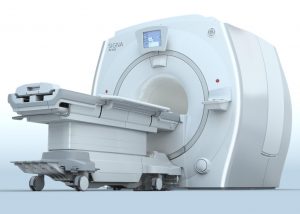BGH Has New, Top-of-the-Line MRI
By Kathy Hubbard

“My doctor said that I will need an MRI and I have no idea what that is?” a friend of mine asked the other day. Obviously too shy to ask the rapid-fire speaking health professional who just assumed that everyone knows what that acronym stands for.
Well, do we? Magnetic resonance imaging (MRI) is a technique that uses a magnetic field and radio waves to create detailed images of our organs and tissues. Easy, peasy!
“Most MRI machines are large, tube shaped magnets. When you lie inside an MRI machine, the magnetic field temporarily realigns hydrogen atoms in your body,” Mayo Clinic explains. “Radio waves cause these aligned atoms to produce very faint signals, which are used to create cross-sectional MRI images, like slices in a loaf of bread.”
These machines produce a 3-D image, which means, of course, that the radiologist who will read the diagnostics can see the area from different angles. The other good thing is that it’s a non-invasive way for the clinicians to examine your organs, tissues and skeletal system in order to diagnose a wide variety of problems.
In April, Bonner General Health completed the construction project to replace the former MRI with a brand new, top-of-the-line model.
“I am very excited for the launch of this new magnet,” Daniel Holland, Diagnostic Imaging Director at BGH said. “It is going to increase comfort for our patients, ease anxiety while in the magnet and get them out of the magnet quicker. The quality of the images will also greatly increase our ability to diagnose complicated pathology. The GE Signa Artist MRI Scanner will have a large, positive impact on our community’s health care needs.”
Imagine lying on a moving slab, unable to move, being transported into a tunnel that makes noises like a jack hammer. Sounds like fun? Well, too bad. The new machine has the largest bore (the tunnel the patient goes into) available.
“The larger bore takes the fear out of having an MRI by reducing the feeling of claustrophobia. It also accommodates for larger patients,” Holland said. “The expansive bore, soft lighting and soothing fans help ease patient anxieties and concerns. The table also has the most comfortable memory foam surface available.
“Traditional MRI tests can be as loud as a rock concert. Our new MRI greatly reduces sound levels. It also has hyper-scanning technology, which means for the first time multiple dimensions of a test can be captured at the same time, significantly reducing scan time, getting our patients out of the MRI up to eight times faster than before.”
Mayo Clinic says that depending on what part of the body is being scanned, you may be given an intravenous (IV) line into a vein in your hand or arm of a contrast material in order to enhance the details of the scan. This material rarely causes an allergic reaction and is eliminated through your urine in about 24 hours. Alert the medico if you have kidney or liver disease as problems with these organs may limit the use of the contrast material.
If you’re anxious about your MRI, you may be given a sedative. If not, you can resume your daily activities right after the test. Then, the radiologist will go to work to report to your healthcare provider.
Since this machine is a really big magnet, metal in your body may be a safety hazard. It can also affect the imaging. So, be sure to tell your medico if you have any metal or electronic devices in your body such as metallic joint prostheses, artificial heart valves, an implantable heart defibrillator, a pacemaker, a bullet or other shrapnel.
Also tell them if you have tattoos as some of the black ink contains metal. And, probably most importantly, speak up if you’re pregnant or think you might be. The effects of magnetic fields on fetuses aren’t well known.
“We are committed to providing our patients with the latest in diagnostic imaging technology,” Holland said. “Our mission is to serve our community by providing excellent healthcare close to home, which is why we offer a multitude of diagnostic imaging tests including 3-D mammography, the highest quality breast cancer screening available; bone mineral density DEXA tests for osteoporosis; echocardiography; nuclear medicine; ultrasound; CT and more.”
Kathy Hubbard is a member of Bonner General Health Foundation Advisory Council. She can be reached at [email protected].
Click Here for More Information about Diagnostic Imaging Services at Bonner General Health
